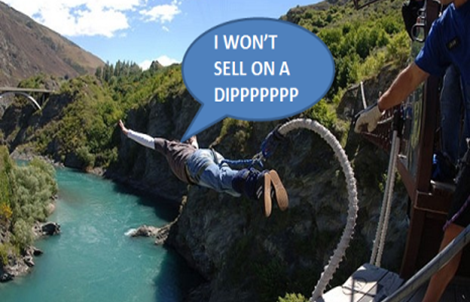I’m dead serious. I know we blog every week and sometimes you just gloss over it. Don’t do it this week. Open it, read it, look in the mirror and get in touch if you want some help figuring out how you feel about risk. I’ll send you a link that can help you understand your own tolerance for risk in less than three minutes. You don’t even need to talk to me. Ever. But I’ll help you even if you want to keep using someone else for advice.
Two Sentences on the Market
Ok, just to get all the market stuff out of the way upfront, here it is in a flash. For October, the S&P 500 was up 2% after falling -8% by the 15th and stampeding back almost 11% by the end of the month. Earnings were good…blah, blah, blah…I don’t feel like writing any more about that today.
Now for the Important Stuff, Read This…
Today I want to write about YOU. And me. And my industry. And risk. And why things have to change for both of us.
Just like I will never get sick of the The Backspin Channel on satellite radio (man I love some old school rap music), I’ll probably never get tired of reminding anyone who will listen that unless your need for liquidity has changed, you should not be selling when the market corrects OR when the market hits a new high. Why? Only charlatans and fools claim to know when to get in and out of the market.
It’s futile to try to time the market in all but the rarest of cases (legging into the market with available cash or out of the market for liquidity needs are two cases that come to mind).
Want proof? Look no further than the annual Dalbar report which shows that the average investor has had an average ANNUAL return of 3.7% over the past 30 years vs. the S&P 500 which has returned 11.1% annual over the same time. Culprit? Take a selfie.
In fact, to take it a step further, the industry is to blame, too. Why? The industry is not well known for doing a great job uncovering an individual’s REAL tolerance for risk. A lot of the problem stems from gathering information from clients during a period of time when they are anchored on recent market success. It’s casually referred to as “Recency Bias” and I wrote about it here. It’s a tough task to translate qualitative responses in a planning conversation about risk into real quantitative data.
To be clear, there is a lot of strength and value in the qualitative data that is gathered in a planning meeting like our Monument Blueprint Meeting and analyzed in our Private Wealth PlanningSM process. It’s just subjective…AND it’s subject to Recency Bias.
A common occurrence is for someone to express that they are comfortable with risk when it’s placed in the context of a percentage number prior to a correction, only to then reassess their risk appetite when a pullback translates into dollar losses on a statement. An example would sound like this…an investor with a $1m portfolio may make a statement in a planning meeting like, “I’m comfortable riding out a correction of 10% over a six month period.” Fast forward to a correction and they say, “Hey, I’m down over $100k this month, so do you have any thoughts about what we should be doing?”
It’s a problem that Monument Wealth Management is beginning to solve with software, algorithms and questions based on behavioral science concepts like Prospect Theory. We’ve done a good job of assessing our clients’ risk tolerance with our Private Wealth Design Process. I can make that statement based on the number of calls we DID NOT get in October…
BUT, we also never stop searching for a better way.
Investors and the advisors in the industry have to change the way they look at and determine risk because when it’s incorrectly determined, inappropriate investing behavior ensues. Advisors should being asking questions not only about a client’s feelings but also ones that determine their biases for gains vs. losses in the context of their entire investment. They should be incorporating questions, models and real numbers. Investors are responsible for fully participating in this too. They need to be forthright and involved in assessing risk. The result should be something that shows a client a range of returns that their portfolio should be staying within over a period of time and falling within a probability of outcomes.
By using models and providing a range of portfolio returns that are a function of the client’s answers, the outcome can and should be as simple as “your comfort zone (tolerance) over the next six months is a portfolio that is down no more than -8% in exchange for a +15% return 95% of the time”.
When clients know their comfort zone, they are much more likely to be invested in portfolio that is within the bounds of their tolerance from the start.
The converse of that is a client invested in a portfolio that is NOT within their comfort zone. It’s usually not a problem when the market is up…but it becomes a problem when the market if down. Like October of this year. That’s when people really figure out what their tolerances are…and it’s often too late.
If you are watching the news and worried when the market corrects 7% (which happens A LOT as I wrote about here… 5% corrections on the S&P 500 happen on average 3.5 times a year and 10% corrections on average happen one time a year) then maybe you are an investor that is invested outside the bounds of your comfort zone and risk tolerance.
Let’s go back to the Dalbar study that I mentioned at the beginning. I know from that study that a vast majority of investors are probably NOT invested in portfolios that fall within their comfort zone…so they panic sell at the bottom of market corrections and wait until they “feel better” to buy back in.
Sound like you?
I also think that the Dalbar study shows that advisors are not getting this right for their clients either. I’m not saying that the industry is not asking questions… I’m just saying that they may be incomplete or wrong all together.
Imagine if you KNEW what your comfort zone was and that your portfolio fell within it? The big firms in the industry are slow to embrace the new technology and the modeling. The good news is that we are well beyond researching it and we are now actively testing it.
Would you like to answer a few simple questions to see what your comfort zone looks like? Drop us a line and we’ll send you a link. If you determine your zone and feel like your portfolio whipsaws outside the range, start asking questions. You can call us with questions and ask for a second opinion or take it to your current advisor and ask them why there is a misalignment.
We Believe in Being Different, and we will never stop searching for a better way. Technology is providing the industry with ways to determine risk tolerances in ways that were never available before. We are taking a serious look at them and if they improve our process, we will be incorporating them.
But no matter what, if you are someone who is selling out of your portfolio when the market corrects, you don’t have a portfolio that is aligned with your risk tolerance. You should fix that.

Important Disclosure Information
Please remember that past performance may not be indicative of future results. Different types of investments involve varying degrees of risk, and there can be no assurance that the future performance of any specific investment, investment strategy, or product (including the investments and/or investment strategies recommended or undertaken by Monument Wealth Management), or any non-investment related content, made reference to directly or indirectly in this blog will be profitable, equal any corresponding indicated historical performance level(s), be suitable for your portfolio or individual situation, or prove successful. Due to various factors, including changing market conditions and/or applicable laws, the content may no longer be reflective of current opinions or positions. Moreover, you should not assume that any discussion or information contained in this blog serves as the receipt of, or as a substitute for, personalized investment advice from Monument Wealth Management. To the extent that a reader has any questions regarding the applicability of any specific issue discussed above to his/her individual situation, he/she is encouraged to consult with the professional advisor of his/her choosing. Monument Wealth Management is neither a law firm nor a certified public accounting firm and no portion of the blog content should be construed as legal or accounting advice. A copy of Monument Wealth Management’s current written disclosure statement discussing our advisory services and fees is available for review upon request.


